The premise is simple: read one comic every day for the entire year. It seems like a simple task but there is no way that I read 365 comics last year, even if you count the individual issues in collections. So, this year, I am committing myself to this reading challenge, in the hope that I can broaden my reading habits and fully engage with my favorite hobby again.
Gary R Bortolotti and Linda Hutcheon stated in an article for New Literary History (Vol 38 No 3) that when it comes to adaptation, “critical tendency has been to denigrate them as secondary to what is usually (and tellingly) referred to as the ‘original.'” This discourse is easily illustrated by scrolling through Twitter whenever a new superhero movie is released, and the vast amount of negative responses hinged on the idea that it isn’t like the original, i.e. the comic books. However, I agree with the sentiments in Bortolotti and Hutcheon’s article that adaptation should stand as its own piece of work and the relationship to the source material should be seen as a journey or evolution from one form to another.
This week I’m reading more adaptations, this time focusing on those comics that are based on movies (and not the ones that are made into movies). Some films spawn vast franchises that often begin with comics. Titles such as Star Wars and Planet of the Apes have thrived in the spaces between the movie releases and they often start with the adaptation of the films. Movies are big business and the comics are part of that, whether through direct merchandising or for the creation of a cultural following.
MFR ON YOUTUBE (latest video)
Help us reach 5K Subs!
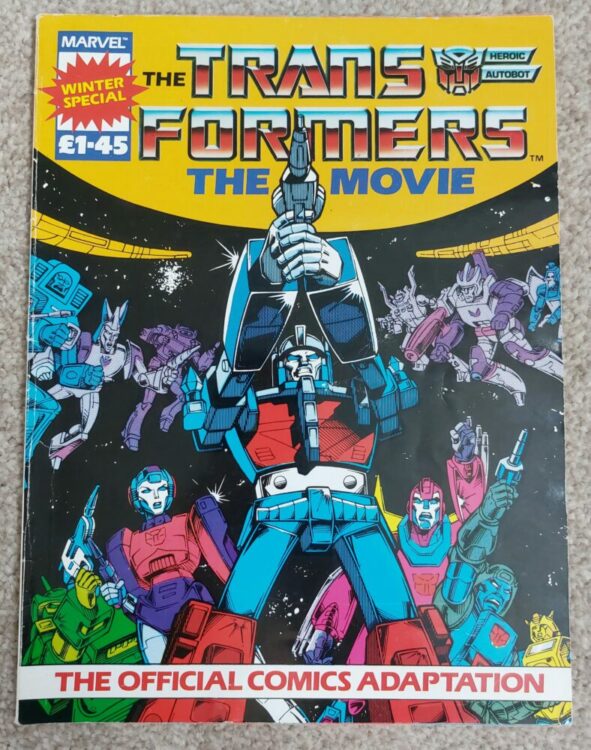
Comic Number 78: The Transformers: The Movie
Last week’s indulgence of 1980’s Transformers comics leads perfectly into this week’s reading and the topic of movie adaptations. In 1986, The Transformers animated movie hit the big screens to the excitement of children everywhere. Several years of cartoons, comics, and toys had captured children’s imaginations and the movie was inevitable.
In the same year, Marvel Comics released a three-part mini-series adapting the film. This was released in the UK in a single Winter Special and included all of the movie action in the palm of your hands.
This comic highlights a number of elements that have to be considered when contemplating adaptation and the translation from one medium to another. With The Transformers, both the movie and the comic were aimed at the same audience, so the tone of one could be matched easily in the other. Also, the concept of fidelity is important in this adaptation because the creators of the comic wanted to give readers an experience as close to the movie as possible. However, one of the most notable aspects of the movie, for better or worse, is the soundtrack, something which could not be reflected in the comic. Personally, I think this is a good thing because the music in the movie is like an audio onslaught that just won’t give up. Watching the movie today gave me a migraine and I was tempted to turn off the sound and just read the subtitles (for reasons involving a Japanese import and a less than high-tech DVD player, it wasn’t actually possible to do that). The cartoon sound effects and some of the verbal characteristics are represented well in the comic by letterer Janice Chaing but a large part of the movie experience, the incessant surround sound of 1980’s soft rock, is noticeably missing.
The effect of this audible space means that a greater emphasis has to be given to the visuals. Unfortunately, the artwork in this miniseries is nothing special. In fact, after reading the numerous comics last week, I would go out on a limb and say that the artwork isn’t up to the standard of the usual monthly comic run. Whether there was a rush to get the comic produced and released, or the design specifications the artists were working from weren’t very good, I don’t know, but there is a distinct lack of care given to many of the panels. For every cleverly composed panel with detailed scenery or character work, there is a page of paint-by-numbers artwork that provides nothing more than something for the narrative to hang from.
The comic lacks the narrative structure of the movie and also the humor, although not all of the jokes worked in the film. Where the comic is most notably different from the film is during the scenes of violence. Optimus Prime and Megatron’s fight fills numerous pages. And where Prime’s death is more harrowing in the movie, Ultra Magnus is tortured to death over several panels, whereas a quick scene cut seals his fate on screen.
Comparing the comic and movie side by side, it becomes clear that the adaptation process here was to provide the audience with a replacement for the film in the period between the cinema and home video releases.
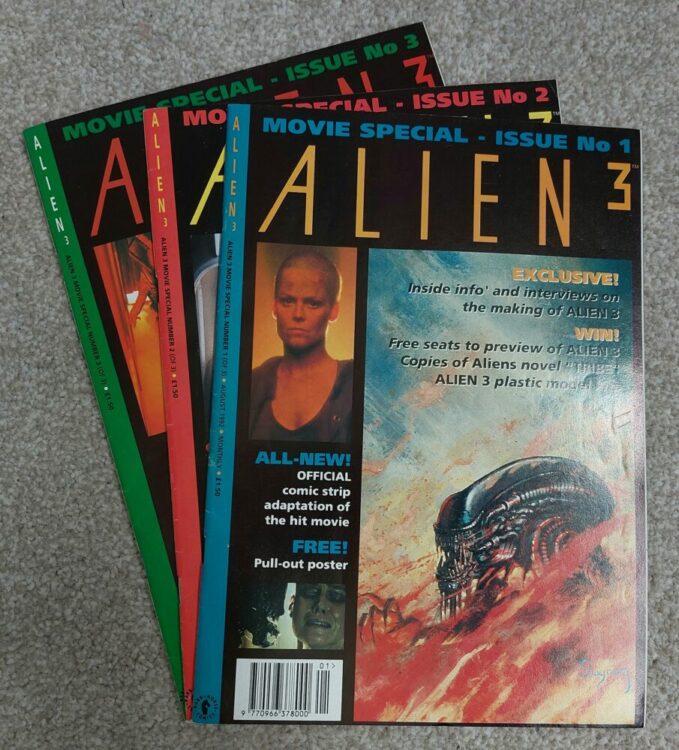
Comic Number 79: Alien 3
The third film in the Alien franchise had a long, difficult journey to the screen, but the hype was big. Everyone involved was really trying to sell the film and make it a success. Merchandising was a big part of the pre-release program and Dark Horse Comics played their part in getting the word out. From August to October 1992, the Alien 3 comic adaptation was serialized and released in one of Dark Horse magazine format comics in the UK, joining titles such as The Terminator, Star Wars, and Aliens, on the shelves. The comic strip itself is an interesting take on the movie with a few additional sequences cut from the film only a few weeks before release. The character design is off-putting, as they were unable to use the actors’ likenesses, and it becomes difficult to tell one character from the next. The final third of the comic is especially chaotic, whether this was influenced by the narrative or just poor planning on the layouts is difficult to ascertain. One thing is clear though, the black page borders and gutters used throughout most of the strip gives the setting and the narrative a claustrophobic feel. As a reader, you become trapped in that desolate prison with Ripley.
However, the most fascinating thing about Alien 3 (issues 1 to 3) is not the actual comic element but the packaging it comes in, i.e. the magazine format. Dark Horse Comics International provided a large part of my teenage reading, focusing as they did on franchises based on some of my favorite movies. The Alien 3 Movie Special not only provided a comic adaptation but news and behind the scenes information about the movie itself. It includes features on special effects, design and story boarding, interviews with the cast and crew, and even a feature on a company producing licensed merchandise. Differing from a number of earlier adaptations, this magazine embraced the fan on every level, giving them something more than just a cheaper interpretation of the story. In the same way that Lord of the Rings DVDs were loaded with extras and features, Dark Horse wanted their readers to experience the whole movie making journey, of which the comic strip was a small part. When you read Steve Grant and Christopher Taylor’s adaptation you don’t really get a sense of scale within the prison, or the detail in the characters development, however the paratextual features and posters help to complete the image. As a reader you are surrounded with information about the movie which you then bring to your reading of the comic. The extra material enhances the reading experience which is not something you get from many other adaptations.
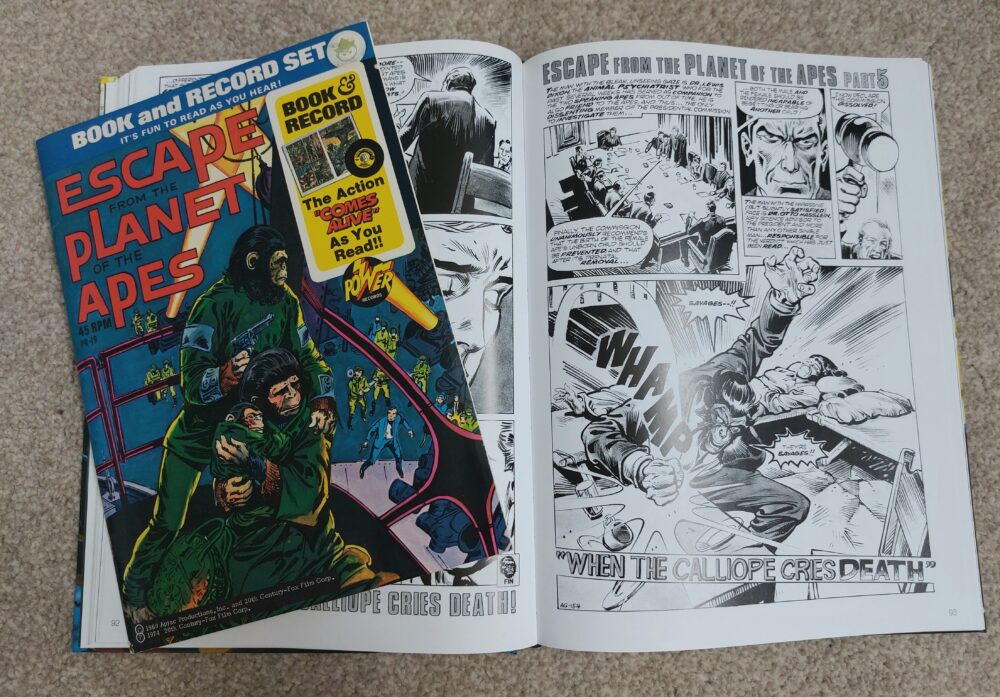
Comic Number 80: Escape From the Planet of the Apes
I picked today’s choice for two reasons. The first is that I have two different comic book versions of this film, so I can illustrate the different motivations behind adaptations. Secondly, the Marvel adaptation came out after the release of the film, not as a glorified advert but as a serious addition to an ongoing comic book franchise.
In the middle of the 1970s, fans’ interactions with franchises was different to today’s on-demand society. Films came and went. The need for adaptations of movies, whether in novel or comic form, was born from the fans desire to relive the excitement of the film. As Rich Handley notes in the introduction to Volume 3 of the Planet of the Apes Archive, “it wasn’t easy for fans to watch their favorite movies unless a theater brought them back for a limited release, or else a local television station aired versions heavily edited [..] However, those who followed Marvel Comics’ Planet of the Apes magazine, published from 1974 to 1977, could re-experience the films as often as they liked”. The adaptations were not temporary fill-ins until the movie was available on video, they had to stand up to constant re-reading and provide a more sophisticated experience.
Luckily for Apes’ fans, Doug Moench and Rico Rival’s five part comic is an excellent example of movie to comic translation. Not only did they capture elements of the movie perfectly in comic form, such as the scene where Milo is killed at the hands of a primitive gorilla, but they also added intricate detail to the visuals. Although not directly a horror, the narrative was more of a social commentary, the pages are filled with references and nods to early, pre-code comics, especially those from the horror genre. Screaming and shocked faces fill panels, each one a different contortion of features.
Moench, working from an earlier script of the movie, also included scenes that were edited from the released movie version. These scenes were cut to allow moments of surprise to have full effect but the comic could use these scenes as elements, such as actors voices, would not ruin the moment. Moench put emphasis on different elements of the narrative, ones that worked better in the comics medium than on film. Quick edits in the movie provided sudden reveals to shock audiences, however Moench used character responses to elicit the same reaction in the readers.
Power Records Book and Record set version of Escape is more akin to the Classics Illustrated approach. The entire film is edited down into 20 pages of comic. The main way that this is achieved is by simply cutting large sections of the story. Milo doesn’t suffer the same fate as his movie counterpart because he doesn’t feature in this version at all. All of the scenes with Zira and Cornelius discovering 1970’s culture are also removed, which eliminates half of the narrative’s meaning and purpose. This version is clearly a piece of merchandise, although the artwork and scripting is very good for a condensed version of a complicated movie.
It’s interesting to note that the comic does not credit the artists/writers but only refers to Arvid Knudsen and Associates. This product is a novelty. A comic/record combo aimed at fans of the film but not intended to replace it.
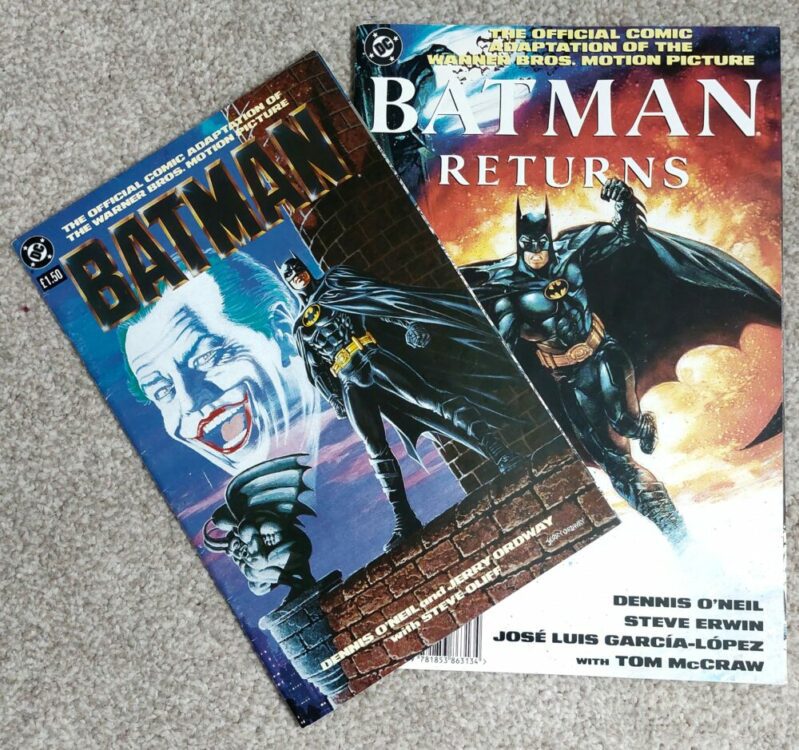
Comic Number 81: Batman (And Batman Returns, because it’s the best Batman film)
One of the things about modern superhero movies is that they are not really based on any one particular comic. Yes, you can draw parallels between a number of different runs or a collection of issues, but as a general rule the movies treat the source material as a cooking pot which they can draw from, keeping and mixing different elements of the stew. This is not a bad thing.
When it comes to adaptations of superhero movies, it creates a fascinating conundrum for the creators and publishers: how do you represent one medium’s impression of another medium’s text using the original medium? Batman was a comic first and liberties were taken to translate it to the big screen. The comic was reinterpreted for the cinema, which is a very different medium, so how can you then revert it back into a comic while maintaining that element of difference that the translation has achieved?
When DC picked Dennis O’Neil to write and Steve Ordway (for Batman) and Steve Erwin (Batman Returns) to illustrate the adaptations, they knew what they were doing. Working directly from the scripts and designs for the movies, the creators have been able to represent the visual flair of Tim Burton’s Batman movies without resorting to the appearance of the other Batman comics being published at the time. These adaptations are significantly different in appearance, however, they still relate to the ethos of the other Batman titles. O’Neil subtly altered elements of the narrative to be more in line with the comic universe; for example, Batman does not kill anyone in the comic whereas it is inferred (almost visualized) that he does in the movies.
By being able to recreate likenesses of the actors, and beautifully representing the sets of the movies, the creators were able to produce clear tie-ins that appeal to the films audience but also, through superb layouts and storytelling, they stand as great comic books in their own right.
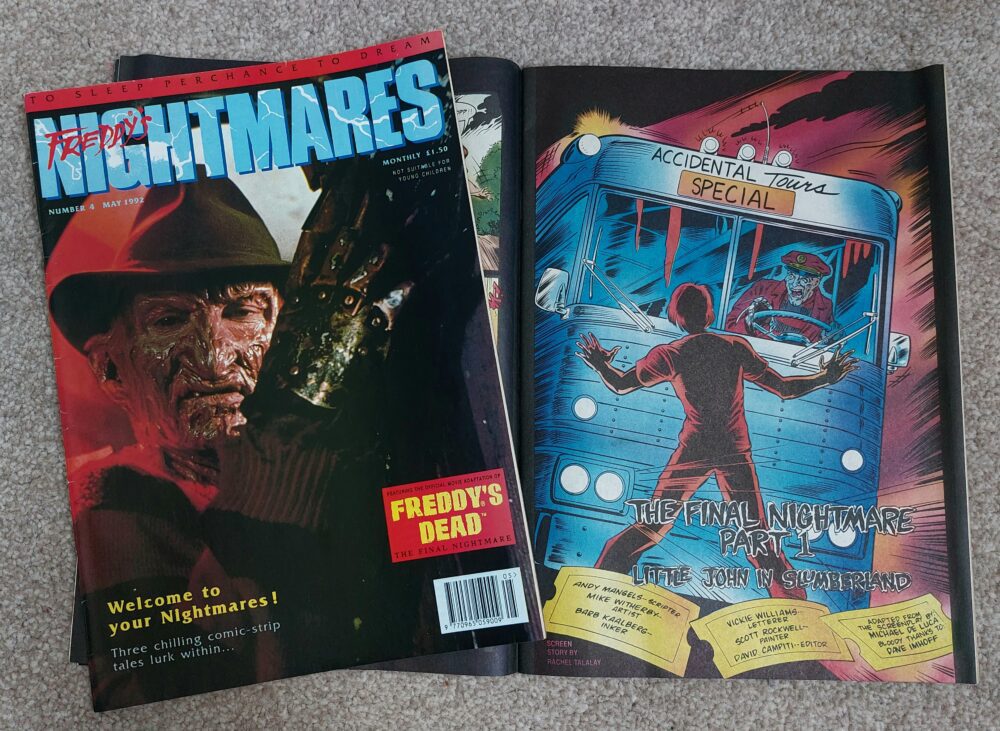
Comic Number 82: Freddy’s Nightmares
What do you do when the main selling point of the film you are adapting is a cinema gimmick like 3D? You just copy the gimmick and release a 3D comic.
The only problem with Trident Comics UK Nightmare on Elm Street magazine, Freddy’s Nightmares, is that when it re-printed Freddy’s Dead: The Final Nightmare, it wasn’t in 3D. Which is a shame because the adaptation of Freddy’s Dead is utterly pointless without the 3D. It’s not really scary or disturbing, unlike the back up strips in the magazine: Dreamstalker and Yours Truly. The first benefits from being in black and white and uses the stark contrasts to create disturbing scenes where your mind completes the horror. And Yours Truly riffs on one of the most terrifying of historical figures, Jack the Ripper. The painted artwork by Tony Harris oozes from the page, thick and tactile in your hands.
Freddy’s Dead adds nothing in the retelling and actually becomes more ridiculous than the movie it is based on, which is saying something. The magazine does, however, boast some other wonderful stories which is a point I pick up on with my next comic.
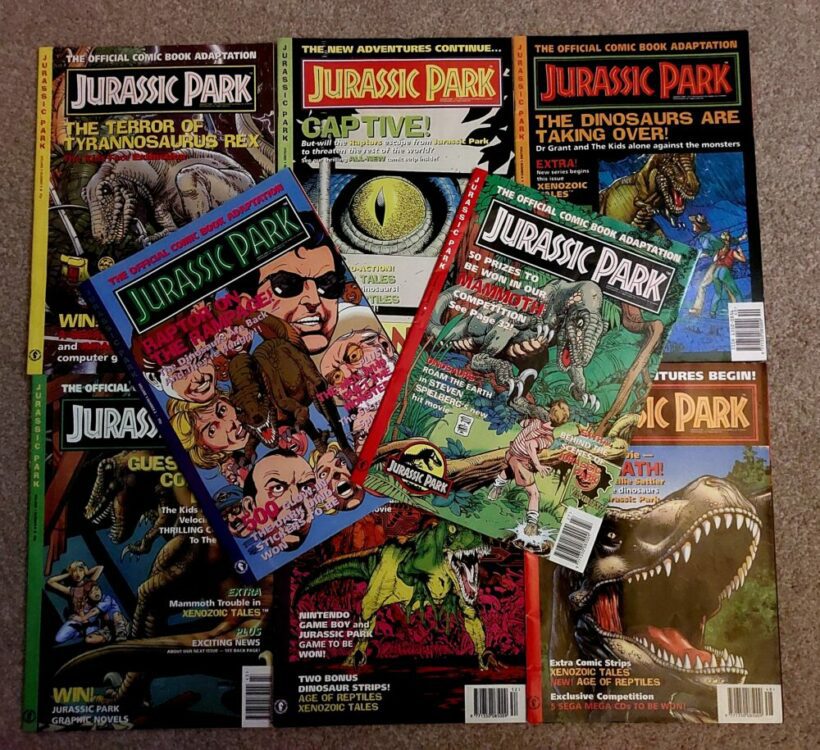
Comic Number 83: Jurassic Park
Cash. Cow.
That’s all I’ve got to say about the official comic book adaptation of Jurassic Park. The narrative is a sanitized version of the movie with the gore removed and the horror dialed back. The artwork is uninspiring and over exaggerated. The comic was designed as a way to make money from the buzz of the exceptional movie.
However, what is exciting about the Dark Horse International (UK) publication of Jurassic Park is the back up strips and continuation of the story (starting in issue 4 and 6 respectively). Firstly, they included Xenozoic Tales by Mark Schultz, first published by Kitchen Sink Press starting in 1985. Schultz uses the comic format to bring out the tension and excitement from his narratives. There is a sequence in the first chapter of Xenozoic Tales where three aspects of a scene are split across the rows of three panels. This creates a grid of panels that can be read across, in the usual manner, or downwards, column by column, while maintaining coherency. It is a magnificent example of comic book storytelling, illustrating that Schultz knows his way around a comic page.
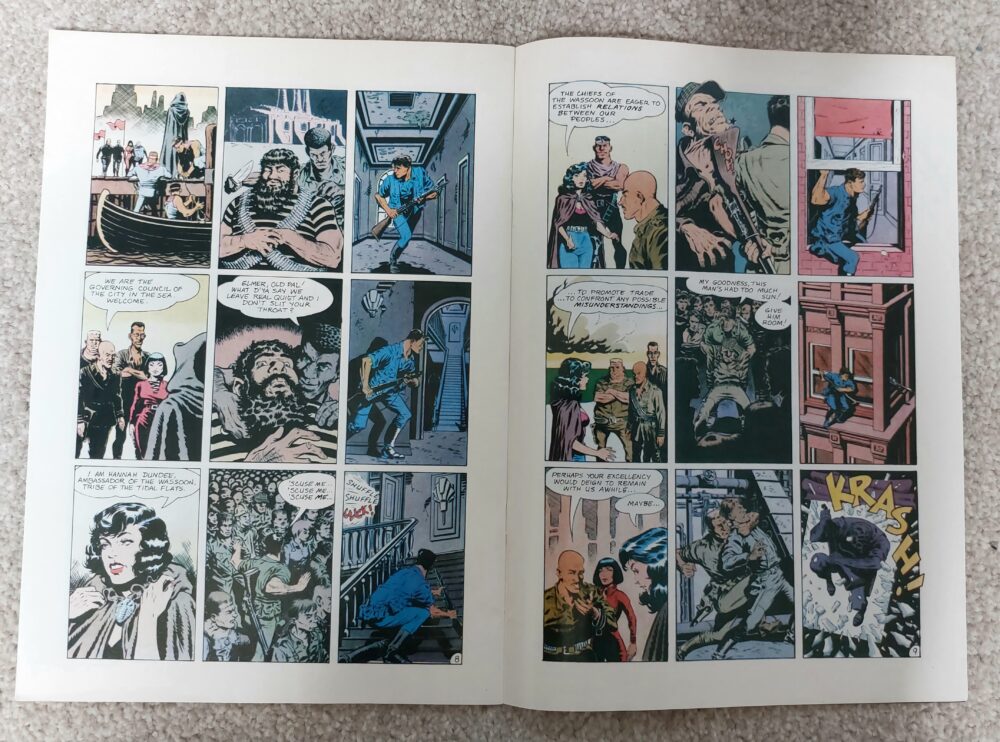
The second back-up strip, Age of Reptiles by Ricardo Delgado and James Sinclair, is a silent comic relying exclusively on the visuals. The combination of color and dynamic panels produces an enthralling narrative about the life of dinosaurs. It is a visual treat.
And then, starting in issue 6 with the story Raptor, writer Steve Englehart and artist Armado Gil begin to expand the Jurassic Park adventure. Continuing directly after the end of the movie, Raptor tells the story of Alan Grant and Ellie Sattler returning to Isla Nubar to supervise the clean up after the disasters of the movie. Although the story itself is nothing particularly exciting, the way it is told is far superior to the movie adaptation. The script is punchy, fitting the comic in a way that the movie script didn’t. And the artwork is dynamic, with page layouts that split the page into a dangerous territory for the characters to inhabit. There is a greater sense of danger in this continuation and has more to say about adaptation than the movie comic does. Raptor shows how the characters and situations from the movie could be represented in a different format to create the same sense of tension, danger, and excitement while maintaining a medium specific aesthetic. In my opinion, they should have got Englehart and Gil in to do the adaptation.
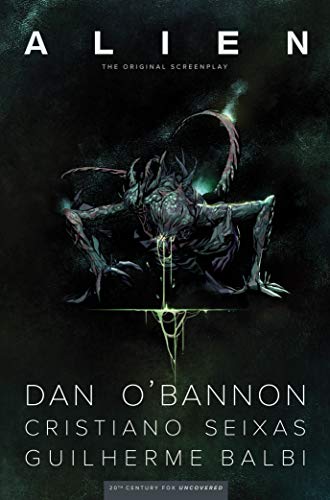
Comic Number 84: Alien The Original Screenplay
Back in 2020, Dark Horse started to release a mini-series based on the original screenplay for the outstanding Alien. This proved to be an interesting exercise in adaptation because they were returning to a fan favorite from over 40 years earlier (therefore not really cashing in on the success of the film) while trying to introduce new elements that would shock and surprise readers.
How successful was it? Well, I reviewed it at the time of release (you can find that review here) and after a few years and a new read through, I still stand by my original impressions. Alien: The Original Screenplay is an interesting attempt to breathe new life into a well known property, similar to BOOM! Studios Planet of the Apes Visionaries, which I have already read this year. Is this an adaptation? Yes, without a doubt, but by using material not previously or widely known it risks being overly compared to the original source material and, by default, is harshly judged.
I started this week with a quote about adaptation, and I’m going to end on one. In A Comic-Book World, published in World Literature Today (Vol 81, No2), Stephen E Tabachnick says that the graphic novel “provides many of the advantages of both print and electronic media while creating a unique and subtle experience all of its own”. When it comes to comic adaptations, the most successful understand the concept behind Tabachnick’s statement and give the readers an interpretation of a film but with a unique style that only comics can provide. The Planet of the Apes comics, the first two Batman adaptations, and others such as Bram Stoker’s Dracula (Topps Comics 1992), Dune (Marvel 1985), and Star Wars (Marvel 1977) have all been able to translate the spectacle of the cinema into comics while maintaining the uniqueness of the medium, making them objects of art unto themselves. Separate from the original but still sharing a link, this makes them part of the same ideas and concepts proving that movie adaptations are still an important part of the comic industry.

